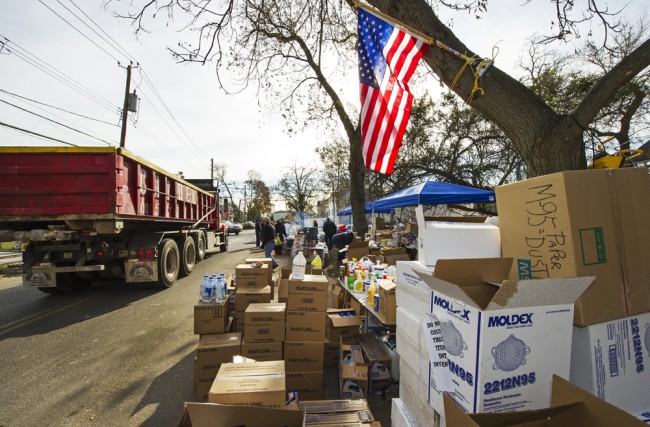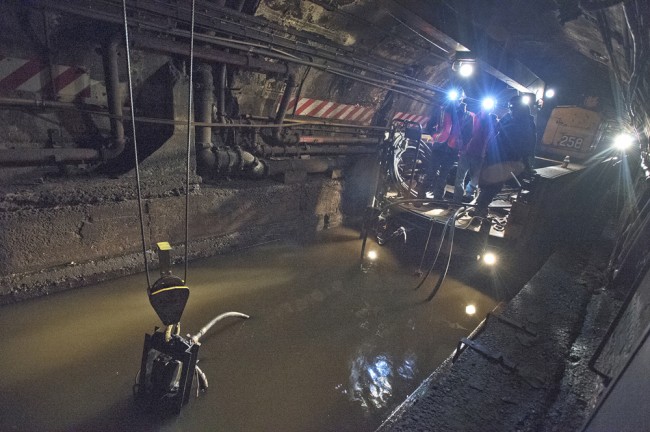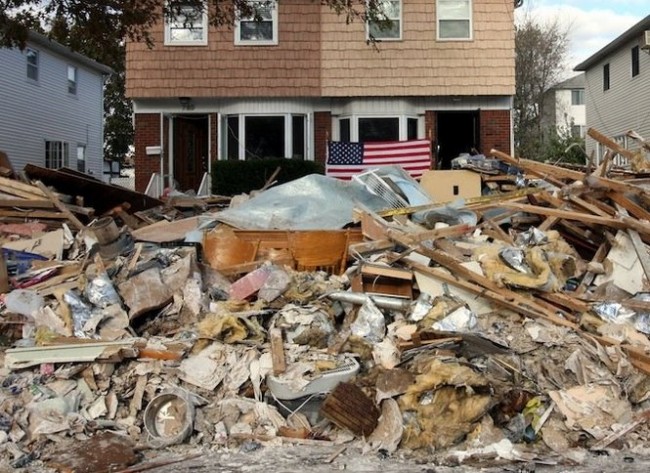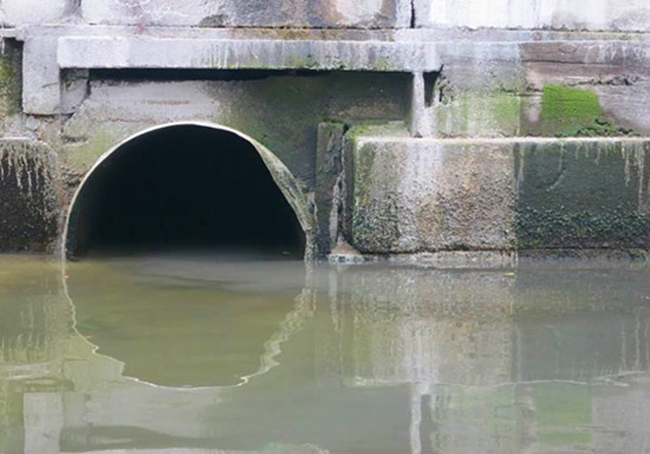
We are celebrating 15 years — and counting — of stories that are deeply researched and deeply felt, that build a historical record of what the city has been.
We are celebrating 15 years — and counting — of stories that are deeply researched and deeply felt, that build a historical record of what the city has been.
The aftermath of Superstorm Sandy and the outcome of Election Day dominated our newsfeeds and our attention this week. And so, this week’s roundup focuses on the same — on how we can better understand what happened when the storm surge hit the Eastern Seaboard, how recovery efforts are faring now, what we can do to help, what needs to happen to prevent this kind of destruction in the future, and how these questions play out on a national, as well as regional and local, stage.

Photo by Paul J. Richards/AFP/Getty Images via Slate
HOW TO HELP
As thousands remain in need around the region and thousands of more fortunate are looking for ways to help, the Occupy movement has re-emerged with Occupy Sandy in an effort to organize grassroots relief efforts. Individuals in need of volunteers for specific projects, areas, calls for specific supplies and food, and more are listed here with contact information so people can help in the most efficient way possible. At the other end of the spectrum, NYC Service has organized all the larger instituions and agencies looking for volunteers for things like cleaning up NYC Parks, donating blood (the blood supply always runs lows during natural disasters), and the Red Hook Initiative. If you have extra room in your home, or are seeking a place to stay, Airbnb (the online service that connects individuals seeking temporary accommodations to people with unused space in their homes or apartments) has created a directory where people can offer unused space for free to Sandy victims. Airbnb has waived all fees and will still provide $1M worth of insurance for every stay. Over 600 people have already signed up to offer space to Sandy victims, but thousands in the region remain in need of accommodations. As many homes have been destroyed or are in need of major repairs, and with many living in temporary arrangements, Manhattan Mini-Storage is offering free boxes, a free move, and free rent to anyone who has been directly impacted by Sandy.
The storm made may of us realize how important certain highly-skilled individuals are in times of crisis. As the city relied heavily on first responders to save lives during the storm, then highly-skilled engineers, electricians, and other workers are needed to get the city back up and running. As part of that effort, the New York Chapter of the American Institute of Architects (AIANY) is calling for architects to help analyze damage and recovery.
All across the city, galleries, restaurants, bars, and venues are holding benefits or donating proceeds to Sandy victims, and many different groups are trying to help out, from community groups, churches, synagogues, schools, to businesses — far more than we could aggregate. Keep your eyes peeled around the city for ways you can support victims in the coming weeks. The most important thing is to help out in any way you can. No job is too small, so just get out there.

MTA employees using a pump train to pump seawater out of the L train’s tunnel under the East River. Photo: MTAPhotos on Flickr
SHUTDOWN
The photos and videos of the flooding, fires, damage and devastation across the region are powerful, and reveal the fragility of our infrastructure and the force with which Mother Nature can assert herself. But the time that it is taking to bring our power, transportation and gasoline distribution systems back up and running again has prompted questions of what exactly happened to these networks to cause such extensive damage.
Gas: As New York City today faces gasoline rationing for the first since the 1970s, The New York Times offers explanation of why the gas shortage persists: “The gasoline distribution system is a sprawling, decentralized network made up of gas stations that have different contracts with distributors to transport gasoline from regional terminals. Those terminals, in turn, receive and store gas deposited by barges and tankers. … Many New York City gas stations rely on distribution terminals in Brooklyn and Queens that were damaged by the storm, or lost power, and have not come back fully, the experts said. Similarly, a major fuel terminal for Nassau County located in Inwood, N.Y., has been operating at reduced capacity.”
Subways: Sandy left 600 million gallons of salt water in the city’s tunnels. The U.S. Army Corps of Engineers was charged with leading a “joint dewatering task force” to get the water out, using pumps that can remove as much water as an Olympic-size swimming pool hold (660,000 gallons) every six minutes. Wired takes a closer look at the types of pumps being used and how the process works. Gizmodo reminds us of salt water’s destructive, corrosive potential in a piece that explains why the city chose to shut down the subway system in anticipation of the storm (to prevent it from becoming “one big dangerous pool of electrified hell”) — a decision and process relived in a piece in The New York Times.
Power: Millions lost power as a result of Sandy, and many are still waiting for their light and heat to come back on. In New York City, downed wires, extensive underground saltwater flooding, and a dramatic substation failure on 14th Street caused what Con Edison names the largest storm-related outage in its history. Across the region, utility companies are getting chastised by customers and Governor Cuomo alike for slow restoration and for failing to sufficiently prepare for the storm.

Seaver Avenue, Staten Island | Photo by Staten Island Advance/ Jan Somma-Hammel
UNCERTAIN FUTURE
A week and a half after the storm hit, the inadequacies of our infrastructure have met with failures of another sort. Many residents of the Rockaways, Staten Island and Red Hook are still stranded without power, heat and water. As temperatures drop and time passes, more reports are surfacing of the disorganization, insufficiencies — or completely lack — of relief efforts from FEMA, City agencies, and the Red Cross. As other parts of the city begin to return to “life as usual,” and our fickle media cycle turns to other news items, those still battling with Sandy’s worst fear they will be forgotten. Much of the city’s public housing sit along the waterfront of low-lying areas, including hard-hit areas like Coney Island, Rockaway Beach and the far East Village. Unsettling accounts of the elderly, disabled and sick, stranded in high-rises, unable — or afraid — to leave their homes to get food, water or information, are inspiring volunteer and community-led groups to show up where the agencies have not. Nick Pinto, in The Village Voice, asserts that the lasting story of Sandy will be one of “the failure of the institutional relief … even with the mind-boggling resources of expertise, money, and infrastructure that these groups possess,” and instead points to the efforts of groups like Occupy Sandy, whose “culture of solidarity and improvisational collective action” can serve recovery efforts well.
Housing
Amidst the urgent, immediate recovery needs, officials must figure out how to provide short- and long-term housing to people displaced by Sandy — a challenging task in a dense city where vacancy is scarce and only so many FEMA trailers can fit. According to the Times, Department of Homeland Security Secretary Janet Napolitano has said that “‘no option is off the table’ for temporary housing, including rental units, hotel and motel rooms, trailers and prefabricated units.” The Staten Island Advance reports that a former correctional facility, a former high school, and ships docked off Stapleton are among the sites under consideration for long-term temporary housing on Staten Island.
Water
The storm crippled New York’s and New Jersey’s sewage systems. For days, due to overwhelmed sewers and power outages at wastewater treatment plants, as much as 1.5 billion gallons of raw, untreated sewage flowed into New York’s waterways. The strength of the storm also caused diesel fuel storage tanks to rupture, spilling oil into the waterways around Arthur Kill and Woodbridge, NJ. The Daily News notes that 630 oil spills have been reported to New York State so far. Paul Gallay from Riverkeeper reminds us that other toxins were released, including “petroleum and fluids from cars and boats; contaminants from flooded subways, roads, parking lots and tunnels; and contaminants washed from shoreline industrial sites, as well as commercial and residential buildings.” In a press release from Riverkeeper last week to heighten awareness of sewage contamination post-Sandy and call for significant improvement to the system, Captain Bill Sheehan, Riverkeeper for the Hackensack River, said “It is unfortunate that it actually took a storm of this magnitude to amplify the miserable condition of our clean water infrastructure, perhaps now New Jersey will begin to recognize the opportunity and take the initiative to upgrade the woefully inadequate sewer systems throughout the State.” Riverkeeper has been monitoring water quality in New York Harbor since the storm and continues to report on their findings.

Combined Sewer Overflow (CSO) discharge pipe in the Gowanus Canal | Photo via Pardon Me For Asking
THINKING AHEAD
Though work still needs to be done to recover from Sandy, many are already asking how we can prevent devastation like this from happening again in the future. Should we take notes from the Dutch (or from Stamford, CT) and build sea gates to protect our shores? (Sorry Rockaways, Jersey Shore, and eastern Long Island — those won’t offer any benefit to you.) Should we think even bigger and create new islands and peninsulas that connect Lower Manhattan to Governors Island (a project previously discussed on UO, here)? Or should we become more “familiar with floods” and be “a city that learns to embrace nature rather than vainly try to fight it.” Others ask if we should be living in low-lying waterfront areas to begin with.
Scientists and academics predicted Sandy’s destruction long before any clouds gathered. Studies documenting potential storm surges – scary in their accuracy – have come from Columbia University’s Klaus Jacob, and NASA’s Goddard Institute for Space Studies, and a team of scientists from MIT and Princeton. Though recent articles pointing to those findings and high-profile exhibitions like MoMA’s lauded Rising Currents in 2010 have helped bring attention to these issues, it seems that it took a realization of those predictions to launch suggested preventative measures into a broader conversation. The construction of gigantic sea gates and other hard interventions have caught the public’s attention, and have become the subject of much analysis and debate. Others propose soft infrastructure interventions, such as those developed during Rising Currents — replenishing oyster reefs, or creating marshy edges and more absorptive streets — would be more economical and easier to implement.
ELECTION DAY
The effects of Sandy on President Obama’s re-election is unclear. But the storm’s impact on what policy area his second term should emphasize is undeniable. Before the election, Mayor Bloomberg, whose post-partisan independence and presumed influence over undecided voters made both candidates seek his endorsement fervently, declared that he thought President Obama would do more to combat climate change, and that Hurricane Sandy renewed his belief that this was the most urgent issue facing the nation. President Obama faced criticism for not making energy or climate more a priority in his first term. And early enthusiasm about the Office for Urban Policy that he set up proved to outstrip the reality of what that office would be able to achieve. Hopefully, the second term will bring strong leadership on energy, climate, and urban issues. Certainly, a lot has changed in the public discourse of cities since the days when “inner city” was shorthand for poverty, crime, and drug abuse. Next American City sums up the cultural shift succinctly: “In the good old days of urban crisis, it was clear what the federal government needed to do: Target lots of resources to cities to root out poverty and eradicate crime. In this era of urban renaissance, though, the role of the federal government can seem less clear. If cities are so economically powerful and so innovative, why should the feds intervene at all?” Atlantic Cities offers eight answers to that question, with a run-down of urban policy ideas the White House should champion, from mortgage finance to infrastructure investment to the gas tax. The Grid Chicago offers a more expansive suggestion about what national transportation policy should look like, calling for integration of high-speed rail policy with a renewed focus on walking and cycling. The post cites some impressive statistics about the economic benefits of these types of investments. For more on how a variety of local ballot initiatives across the country change the landscape of transportation policy, check out Yonah Freemark’s thorough analysis on the Transport Politic.
The Roundup keeps you up to date with topics we’ve featured and other things we think are worth knowing about.
The views expressed here are those of the authors only and do not reflect the position of The Architectural League of New York.